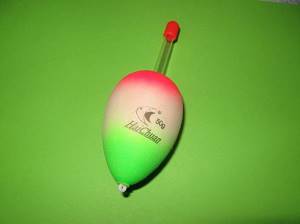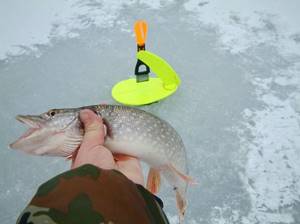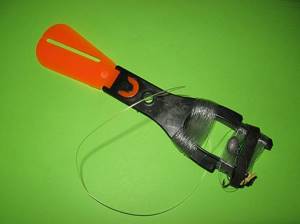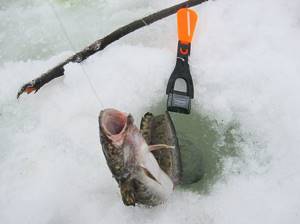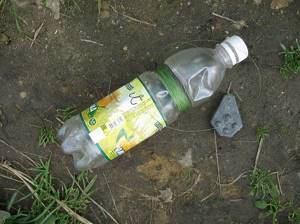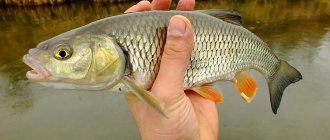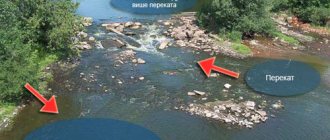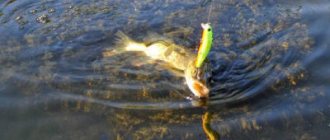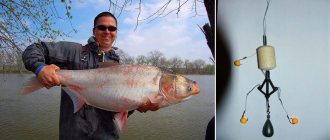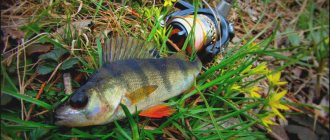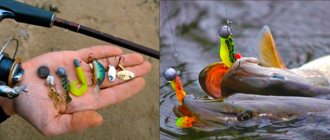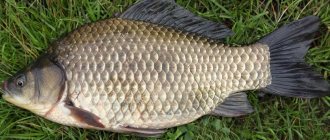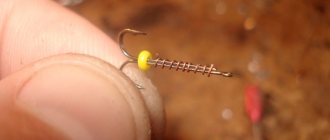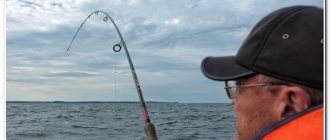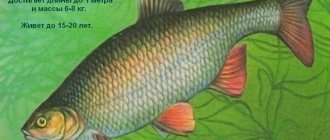Content
- Catching a trophy starts with a map
- Search for a predator on the river
- Promising site
- Side-scanning echo sounder help when catching a predator
- Lures for catching trophies
- Trophy on a hook
- Search for a predator on the river: VIDEO
Each of us always wants to find time for a long trip to unexplored places where the river abounds with large fish. Trophy fishing attracts everyone who has at least once had the good fortune to find, catch and put a strong and beautiful predator into the landing net. And for this we are ready to do a lot: take a vacation, spend a lot of money on gear and travel, spend the night in a tent on cold autumn nights. But what about those who do not have much fishing experience behind them and are only planning their first trip away from the city? How do you know where to go and where not to go? How to determine which place on a large river is promising for catching a trophy, and which is less promising?
Using the example of one of my trips, I will try to tell you how I do it. You will see the real stages of planning fishing spots and what difficulties, in fact, you may encounter, even if you first sort everything out. Fortunately, serious cold weather has set in, open water fishing has stopped and there is time to write an article.
After reading this article, you will not receive comprehensive knowledge on finding fish, but you will see one specific example in which this can be done.
Small rivers provide an autumn predator
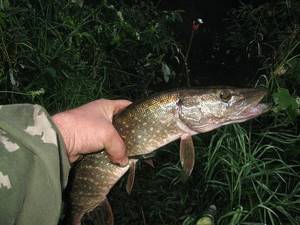
Photo: Alexander Tokarev. But even then, perch, pike and pike perch hunt just as fiercely for small fish. Their activity decreases only in the middle of winter.
But let's go back to autumn. Despite all the favorable conditions for good predator fishing with artificial baits, on small forest rivers the predator is often capricious and refuses to take all types of spinners and wobblers.
Or he takes it periodically and only at certain times of the day. Moreover, its outputs on small rivers are short-lived. And the closer winter gets, the worse the situation is for the predator, in particular the pike. But this is only for spinning.
Catchy live baits
On small forest and meadow rivers, which our Russian side is rich in, live bait fishing rods and bank fliers are very effective. Of course, girders that are installed from a boat in places with aquatic vegetation can be no less effective. But since we are talking about a live bait fishing rod, then the girders can then be placed from the shore.
After all, a small river is never wide and access to pike places here is much easier and closer than on a large river and lake.
On a small river, whirlpools with reeds and strips of vegetation are located along the bank. And all you need to do is toss the bait with a fishing rod or hang a flyer bait next to the grass.
Let's start with the fishing rod. You will need a long rod with a live reel or a relatively long rod with a spinning reel.
The simplest tackle is the first version of the classic fishing rod. It uses blind equipment. And the principle of such fishing is not much different from traditional fishing for some kind of roach or perch, but the float is much larger and its carrying capacity is usually equal to the weight of a medium and large “olive”, that is, an elongated sinker weighing about 8-10 grams, and sometimes heavier .
The rod should be light, since you will have to keep it mostly suspended. In addition, the form must have excellent strength and rigidity. All these qualities are inherent in fast and ultra-fast action carbon rods.
The wire reel is supplied with monofilament fishing line four tenths of a millimeter thick. At the end of the main fishing line, a sinker is attached, a swivel with a clasp, a metal leash and a number seven treble hook, maybe a little more if there is a large predator in this place.
The float has a blind fastening at two points, as on a regular float fishing rod. This classic fishing rod is used in shallow places near the grass.
On pit edges and pools, sometimes you need a fishing rod with running equipment and a float that slides freely along the line. It is necessary when the depth at the casting point exceeds the total length of the rod.
The sliding large float does not have a blind fastening. It moves freely along the fishing line, which is threaded into a ring on the bottom of the float.
|
| Live bait sliding float. Photo: Alexander Tokarev. |
Before casting, the desired diving depth of the live bait is set by moving the rubber knot along the fishing line. This knot will be a stopper for the float. After casting, it will rise from the sinker to the surface and rest against the knot.
It is better to wind a somewhat thin fishing line or braided cord onto a spinning reel so that the tackle works more sensitively and the casts have a full range, which will not work with a thick and coarse fishing line.
Live bait is thrown to aquatic vegetation, where predators hunt at the border of the pit and coastal shallow water.
The best live bait is the roach, but the bleak also attracts the predator very much, although it does not live that long on the hook. The gudgeon is considered an excellent live bait, but it is not found everywhere.
The flier is installed from the shore. It is suspended on a pole, which is attached with a spear and a spear in reverse, as when installing a float fishing rod, only these elements here should be much stronger.
The popular and simple ones are summer girders made from the forks of bushes, but there is an option where a girder for ice fishing - Akara - is used as a universal tackle.
|
| Zherlitsa for its intended purpose. Photo: Alexander Tokarev. |
To do this, the reel with equipment and flag is released from the rack mounting. A cord is threaded through the center of the reel, from which a simple loop is made. Then this loop doubles and turns into a noose, which is thrown over the tip of the pole and tightened.
|
| “Winter” girder for autumn fishing. Photo: Alexander Tokarev. |
A rubber knot is tied along with the fishing line on one of the forks of the reel. It rests on the tip of the reel, holding the line so that the bait fish cannot tear it off ahead of time.
During an attack by a predator, the knot breaks off and rolls down to the sinker, and the fishing line unwinds from the reel, during which the predator swallows the bait.
This tackle is sometimes much more effective than spinning. Winter girders of a similar design and from various manufacturing companies are now increasingly appearing in the arsenal of fishermen and, probably, this is due precisely to the versatility of such girders, which can serve for their intended purpose, that is, for fishing from ice and at the same time for catching burbot with the installation of gear under ice.
|
| Hanging version of the girder. Photo: Alexander Tokarev. |
Well, as was said above, this same zherlitsa successfully catches a predator in the summer. And among the alterations and modifications for summer time, you only need to thread a nylon cord or fishing line into the hole in the center of the reel and tie a blind loop.
For ice fishing, the loop of the cord is removed and the reel is reinserted into the stand mounts, which only takes a few seconds. True, I made more noticeable changes in the appearance and functionality of Akara girders, which are also in my arsenal of gear.
In the likeness of the flyer girders, I removed the jumpers on the girders, which were located on the reel in its lower part. The result was real flyers. What did it give?
Now you can reel in more fishing line if you use gear for winter fishing at depth. And in the summer, it became possible to wind a line in the shape of a figure eight on such plastic flyers. Then, when a pike or other predator grabs, the flyer does not rotate in one direction, which sooner or later leads to abrasion of the cord after regular twisting, but only swings from side to side. At the same time, the fishing line easily escapes from the flyer.
I left the rest on the rails as is, even the flags. During a pike attack, they swing on a pole and attract attention. And when the predator, having swallowed the bait, stands in the grass, the flag on the tightly stretched fishing line, slanted into the capsules, will be visible from afar and from its position it will become clear - the predator is sitting!
Donka bottle
On our recent trip to a small suburban river, we essentially found ourselves in a complete lack of bite, although the weather was amazing, very reminiscent of “Indian summer.” It didn’t take at all on the feeder, although all summer quite good underbreeder was biting well here, and a roach was caught on the Bonduelle corn, which in size could compete with the Volga magpie.
My friend’s spinning rod didn’t have a single pike bite, and even the perches didn’t chase the spinners. It would seem that a pike would definitely take the Atom spinner.
Down the river I caught pike well with this oscillating spoon and at the same time, but I didn’t take a spinning rod for this fishing, as it turned out, not in vain. Sergei wasted an hour at sunset and an hour at dawn with his spinning rod.
I took live bait donks with me. And when I got tired of watching the quivertype of the feeder in vain, I attached a thin float rig with a swallow hook to the fly rod, hooked a maggot and threw it to the border of quiet water and the current, where circles diverged from the autumn bleak fattening on top. And she began to peck desperately, as if this was all she had been waiting for.
Finding gaps between the willow bushes, I placed three donkey bottles with bleaks mounted on the tees. In the evening there was not a single bite. I suspect because of my mistake. I hooked live bait bleaks under the dorsal fin and they obviously rotated in the current like propellers. And when I checked my donks in the tent before going to bed, there were no live fish on any of them.
The weak bleak was chattered away by the current
In the morning the bleak did not bite. Only when the sun rose did I, with difficulty, catch several bleaks and bait the hooks of the donks, now placing the bleaks on the lips. Soon the sound of a large feeder bell was heard, which served as a bite signal.
We caught a pike weighing more than a kilo. Then I came across another one. In the short period before our departure, two pike were caught using live bait. And this is for three donks. Meanwhile, as already mentioned, there was not a single spinning trip.
The bottle donka is an ordinary throwaway, the reel of which is a plastic bottle. For me these are 0.5 liter lemonade bottles. The main thing is that the bottle has a recess for the fishing line.
In addition to the primitive role of a reel for winding fishing line, the bottle carries the load as a simple inertia-free reel if, when casting, it is directed towards the river. Then the line will reel in easily, just like with an open line handle on a real reel.
|
| Donka bottle made from scrap materials. Photo: Alexander Tokarev. |
True, you shouldn’t use a monofilament line thicker than 0.4 mm in diameter. It will spring and cling, especially if the fishing line is stiff. Braided cord is better, but there is a risk of getting a “wig” or “beard” from it, as fishermen ironically call a lump of tangled fishing line. A braid is like a thread.
Such simple donkey bottles allow you to throw gear in places where it is impossible to do this with a regular cast because the bank is overgrown with rose hips, willows and grass, since in such places you cannot lay out the fishing line in rings. When casting there will definitely be a hook.
The equipment of a live bait donkey bottle is simple. Half a meter above the sinker, a leash made of fishing line about 30-40 cm long and a short metal leash with a tee No. 7-7.5 according to domestic numbering are tied to a triple swivel.
I usually cast this way. I put a tee with a fish on a flat sinker and, holding the bait with my finger, I lightly throw the sinker away from me, since long casts are not required, since a hole is selected for fishing near the shore. Then the fishing line is inserted into the split on one fork of the willow twig, and the bottle is put on the other fork.
By the way, it’s easier to find gear on the shore at night. A large feeder bell is attached to a fork with a fishing line. This will be a quivertype donkey. A bottle with a supply of fishing line can be attached for insurance by tying it to a peg on the shore. What if a big fish takes it?
Alexander Tokarev September 13, 2021 at 11:46 am
Catching a trophy starts with a map
The first thing you have to indicate is the distance you are willing to move away from the city of Novosibirsk. Gasoline costs, travel time, how quickly you can return home in case of an emergency - these are the key points that should resolve this issue.
This time, nothing stopped us from moving further away. And already at home we began to look at maps to select the most interesting section of the river. And the choice fell.
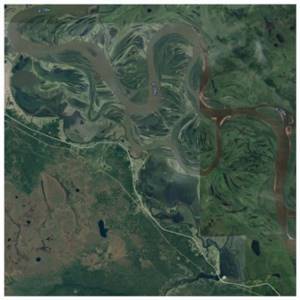
This section of the river is of interest at first glance, primarily because the river bed has many turns. Why are we interested in channel turns? It's simple - the turn of the channel always implies the main current and its specific boundary, since in these places it goes at an angle relative to the banks. In addition, wide “platforms” with moderate or weak currents often form here, where you can often find rampant predators, the so-called “zhor”. And since I am not a fan of narrowly local places with fish on duty, it is precisely these that I focus on.
Turns in the channel most openly indicate possible promising places already at the stage of viewing maps.
Then we delved into the maps in more detail and determined that the bends in the channel are protracted, have extensive sands, or have a significant narrowing of the distance from bank to bank beyond the bend downstream. These are the main points that allowed us to mark the areas we will head to upon arrival.
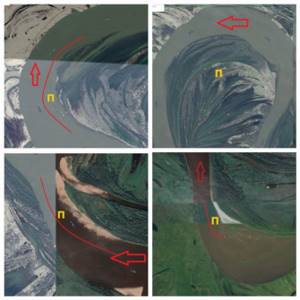
Only some of the sites are presented here to understand the principle of searching for places on the map
The arrow indicates the direction of the flow. The letter “P” is a promising area. In the top right picture, the designation “P” is in the middle of the picture, since, theoretically, this area is interesting from all sides.
With limited time, it is extremely important to know in advance where you will go in search of a trophy after launching the boat. There should be at least several such places.
Jig fishing technique
You must immediately decide that jigging on a middle river from the bank has little prospects. Strong currents, a large number of hooks, and often difficult approaches to the water encourage the angler to use a boat. The boat also allows you to guide the bait along the best trajectory.
Video on the topic
Video: jig wiring
Click Play to view
You need to start fishing an interesting place from the entrance to the hole and then slide downstream. That is, we stand on a point, fish it, and then slide downstream 10 - 15 meters and fish again. So until you leave the pit. If the hole is interesting or there were bites, then you can go through it again along a different trajectory. Casting should be done downstream or at an angle to it. The smaller the angle to the current the bait is thrown, the better it is controlled.
The wiring of the bait may be different. The classic version: two to three turns of the coil and a pause. It should take 2-3 seconds before you touch the bottom. With this type of fishing, the bait moves in smooth wave-like jumps near the bottom. Another option: sharply raise the rod a meter (approximately) and lower it back, picking up the slack in the line with a reel. We wait for a pause of 2–3 seconds. In this case, the bait rises sharply above the bottom and falls smoothly. There are many wiring options and you shouldn’t get hung up on just one of them. Success awaits those who love to experiment.
And about fishing in snags. Don't be afraid of snags and skip such places. The predator is very fond of tree debris and constantly stays there. But you have to catch it carefully. During pauses, you need to carefully “listen” to the rod. And if you feel it touching the snags, you need to lightly cut. It happens that the bait jumps off the crook. If a hook does occur, do not pull the bait towards you too much. There is a method that saves you from a cliff in 80 percent of cases. You need to throw 15 meters of fishing line downstream, let it stretch, and then with a sharp movement jerk the rod towards you. Use a reel to pick up the resulting slack and repeat the maneuver. Do this until the line is stretched again. Usually one time is enough, but if the bait does not come off, you can repeat the method again.
Search for a predator on the river
Fishing is an unpredictable thing. Arriving at the shore, we were greeted by a strong wind and a serious wave for our PVC boat. But, you can’t go back and we are heading for a “run” through the places that we had previously marked for ourselves.
In an unfamiliar river area, you always need to be prepared for the unexpected. This is fine. Somewhere, something washed out and the place that seemed interesting to you was left completely without flow. Some of the places are lined up and down with fishing nets. And somewhere, in one of the marked areas, we met a whole fishing team, where a ship casts a giant net from the water, and a tractor drives it from the shore. Thus, a gigantic section of the river simply became shallow without any checks.
Some sands have a good current, acceptable background depths, they have food and predatory fish, but they are located in the leeward area and it is extremely difficult to fish here. Other sands are simply shallow and uninteresting. And just like that, the number of our marked places is naturally reduced to three or four of the most promising ones.
Any place that seems interesting on the map requires checking and can easily turn out to be unpromising for finding a trophy predator.
Using one of the sites as an example, let’s move on to the next stage of the search.
Promising site
And now we are on that section of the river that lived up to expectations and, as if, says to you: “Well, come on. Let's see what you can do!”
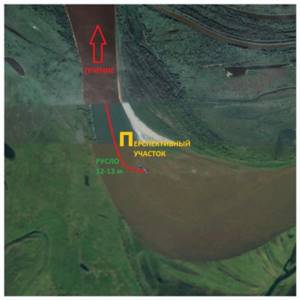
The location represents a 90 degree turn of the river. We are interested in the right bank, directly around the bend. As we can see from the satellite image, in this place the distance from coast to coast is sharply reduced. This is a very significant criterion, since the wider the river in the place that we consider promising and the wider the very area that we will explore, the more difficult it is to find the fish we need on it, the more tied the fish may be to local bottom reliefs, schools of forage fish, etc. And we don’t want to spend too much time looking for it.
So what we have here:
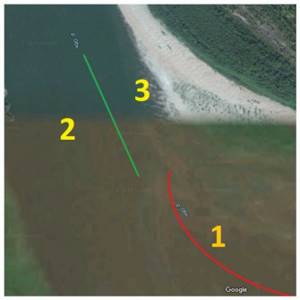
Before turning along the right bank there are extensive and, at our water level, shallow sands. They do not arouse strong interest, since the background depths are shallow and the availability of food supply is meager. Marked with a number in the picture «1»
.
Around the bend, the river bed presses against the left bank, its depth here is 12-13 meters. Marked with a number «2»
.
Under the right bank, around the bend, a relief clearing is formed, about 200-300 meters long and 100 meters wide from the right bank to the riverbed (the numbers are very approximate), which is pressed as tightly as possible to the river bed and has a moderately weak current. Not sands. Background depths are 3.5 – 7 meters, depending on the setting on the site. Marked with a number «3»
. This is where we will now look for decent fish.
Necessary criteria for this type of place:
- Relief and difference in depths in a promising area (perhaps just dunes with a gradual increase in depth).
- Presence of food supply (fish gathered in schools in the bottom layer of water). We were interested in a large predator, so we tried to find a larger one.
- The presence of a predator of the required size on the site or adjacent riverbed.
How to use baits and retrieve them
It is not enough to find a place where a predator gathers. It is very important to use the right baits and choose the right wiring. You can throw it directly at the head of a predator, but you won’t get a bite.
For example, if you use a jig head that is too heavy, the pike perch will spit out the hook over and over again. In this case, it will not be possible to detect his hard mouth. But the opposite situation can also happen, when the pike bites during a short pause. To make the bait fall faster, use a heavier jig head.
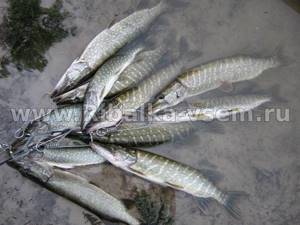
It is sometimes easier to persuade pike perch if you make a step in the water column. Well, most often, of course, they use slow wiring in the bottom layer or dragging along the bottom.
On hot summer days, the predator often rises to the upper layers, hunting for white fish. Pike finds grassy areas, and pike perch occupies holes located near shallows. It is necessary to be able to select the right baits for different conditions. If you fish in wide bays with shallow depths, then use more wobblers, poppers and spoons. Make wiring in the upper and middle layers.
Separately, it is necessary to say about asp fishing. In wide water areas you can always find places where the asp forms cauldrons, driving the fry around a certain area. This happens in August. If you find yourself in such a place at the right time at least once, you will remember this fishing trip forever. Castmasters, wobblers and spinners are used. Sometimes there are pike perch and perch next to the asp. In such situations, fishing becomes even more interesting.
Side-scanning echo sounder help when catching a predator
Here the side-scanning echo sounder comes into full play. It allows us to cover a large area of water with our beams, clearly reach the largest food supply in the area and determine the presence of a predator. With the help of an echo sounder, we significantly reduce the search time in the area, we can draw more accurate conclusions from what we see and quite accurately position ourselves on the water according to a landmark.
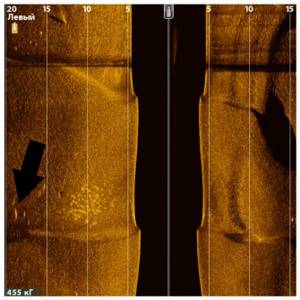
In the absence of my own screenshot, I’m inserting a screenshot I made a long time ago with a Humminbird Helix 12 echo sounder, sensor - xhs 9 hdsi 180 t, Chirp. A classic of the genre - a gathered flock of small whitefish, with several shepherds nearby (rounded silhouettes in the flock - whitefish, probably bream, longitudinal silhouettes at a short distance - a predator). They stand under a transverse dune - a slight difference in depth. A transverse stripe on top - a failure with a sharp drop in speed.
Forage fish appear as more rounded spots on the echo sounder display. Predatory fish (under the arrow) appear as longitudinal silhouettes. The sizes are determined experimentally, using passes over different fish. To determine the size of the fish, you should also take into account the depths at which it stands. I will say, since this will still be useful for someone - it is hardly possible to determine the weight of a fish from the display, even with an error of a couple of kilograms. But, you can almost always focus on larger fish and distinguish a specimen of 1-3 kg from 7-12 kg.
In our country, at the moment, a huge amount of fish stands on the riverbed dump, at a depth of 8-10 meters, but is not caught from these depths. With several passes through the area, we mark the site of a large whitefish where the predator is standing, in an area with a moderately weak current at a depth of 4-6 meters. We understand that these days the fish are sensitive to motors and run away after each pass on it or in its vicinity. We cannot position ourselves normally for the fish and decide to simply stand at the depth it is currently holding and wait.
Sooner or later, channel fish will come out to this calm area and eat.
The presence of a suitable food supply and a large predator on the echo sounder display does not mean that fishing will be successful.
Autumn fishing for predators in small bodies of water
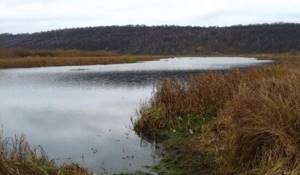
With the gradual cooling, catching predators in small bodies of water in autumn becomes of particular interest. Withering vegetation descends ever closer to the water, yellowed leaves fall to the surface. All this creates simply ideal conditions for it, which often sets up ambushes in the coastal zone.
You can fish either with a float rod using live bait or with a spinning rod. In the first case, you will need a fairly rigid rod, up to 4 meters long. A mistake that beginners often make is that many do not even suspect the presence of trophy specimens in that very small river. Accordingly, the tackle is chosen with the expectation of catching small fish, which fail at the most crucial moment. By the way, there are certain factors that indicate the possible presence of, say, the same large pike in small reservoirs. First of all, this is the food supply of the reservoir - with a large amount of small fish, it is quite possible to have large pike and perch. The reservoir does not freeze completely - another important condition for the growth and development of the predator.
As live bait, you can use small crucian carp, roach, and minnows - preferably caught in the same reservoir. With spinning, the situation is somewhat more complicated, since often in such reservoirs the predator turns out to be more picky. In many ways, fishing is complicated by numerous snags on leaves and remains of aquatic vegetation.
As a way out of this situation, I can recommend re-equipping the spinners. Those. Instead of tees, we use ordinary single hooks that are suitable in size. Of course, in this case the chances of a successful strike will be somewhat reduced, but the number of effective runs will increase significantly.
If you fish with wobblers, I can recommend a series of minnows; often they even turn out to be beyond competition. Only then, closer to October, switch to jig. Here you don’t have to fish the entire coastal zone in search of a predator - look for it mainly in holes and pools. This mainly applies to pike.
The wiring is standard - a few turns, then a pause. At the moment when the bait passes through the holes and dumps, we pause longer.
As for the fishing rod, the best option would be an ultralight spinning rod, up to 2 m long, with a fast action. This criterion is especially important, since you need, first of all, accurate casting and good sensitivity of the tackle.
Since the summer fishing season is gradually coming to an end, why not diversify your vacation a little, for example, go somewhere to relax. And so that you don’t have any problems finding the best hotel, I advise you to read the reviews on the website turtella.ru.
Lures for catching trophies
As a rule, in the fall it makes no sense to rinse small baits if you want to catch large fish. The mouth rejoices at a large piece - and this has long ceased to make sense to discuss. Of course, you can catch anything, but since you are in the mood for big fish, use the largest possible baits. And if we are talking about pike, then there should definitely be no restrictions here. Pike easily swallow individuals half their size. Imagine for a second what size prey a pike weighing 10 kg or more can eat. 50 cm of driven bait will fly into her and she will not notice. And we often look at 20-centimeter baits and fear them like fire. This is mistake. A mistake caused by a lack of experience in catching pike with large baits. In pursuit of trophies, they are necessary!
The use of large baits requires gear of appropriate power.
On this trip, the best fishing quality was achieved with a 20+ cm handmade streamer, which proved to be much better than silicone. The following rubber models were used in different colors:
- Keitech Easy Shiner 8"
- Mann's Q-Paddler 18 cm
- Relax Twister 6”
Trophy on a hook
Bad weather: wind, rain, snow. This time we met everyone. It was really hard to catch. The fish went on strike. At moments, it seemed that any capture in these conditions was already a success. And yet, the puzzle came together and, in spite of everything, we caught our fish.
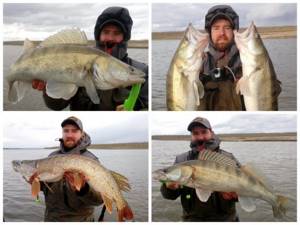
The river left us without particularly large specimens, but showed that our thoughts on choosing a place were correct. Pike perch and pike were caught at this point strictly during breaks between strong winds. These breaks were quite short. We believe that under these conditions we did not do the worst fishing. Patience and confidence in the chosen section of the river helped us.
To summarize, using this fishing as an example, we can formulate the concept of searching for fish in an unfamiliar water area in the fall:
- Determining the distance to a place
- Working with a river map, selecting potentially promising places
- Quick check of marked places, passage through sections
- Selecting the most suitable areas for catching large fish
- Detailed study of the selected area, “bold landmarks” on the scanner display (large, knocked down food supply pressed to the bottom, large predator)
- Using large baits
- Determining the correct setting
Well, personal. Perhaps controversial for some, but nevertheless, they don’t run after the trophy. They are looking for him, adapting to him, waiting for him. When running from place to place, I always prefer to devote time to one section of the river that meets all the requirements for it. And let it be at least the whole day.
Reducing travel time from place to place to a minimum is my main principle.
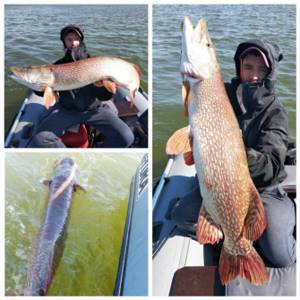
Using this algorithm of actions in practice, you will significantly reduce your search for fish on the river in the fall and will quickly achieve the catch of the fish you want.
To Catch a Predator: Veteran Crime TV Show
Christopher Edward Hansen was born in Chicago, Illinois on September 13, 1959, and attended school in Bloomfield Hills, Michigan. In an interview with the Lansing City Pulse newspaper, he said that at the age of 14, while watching the investigation into the mysterious disappearance of union leader Jimmy Hoffa, he got the idea of becoming a journalist.
Chris Hansen photography
Chris graduated from Michigan State University College of Communication Arts in 1981 with a bachelor's degree in telecommunications. Even before graduating, he landed a job as a reporter in Lansing at NBC-owned WILX.
Advertising:
He later worked at WFLA in Tampa, various radio stations and newspapers in Michigan, WXYZ in Detroit and has remained an anchor and investigative reporter at television station WDIV since 1988. In May 1993, Hansen joined NBC News as a correspondent for the news magazine Now with Tom Brokaw and Katie Couric.
Chris Hansen photography
Christopher's noteworthy work on the Dateline NBC reality series included coverage of the Columbine High School massacre, the Oklahoma City bombing, the story of Theodore "Unabomber" Kaczynski, and the Boeing 747 crash near New York ( NY).
Also worthy of mention is Hansen's investigative reporting on illegal child labor in India and the counterfeit drug market in China. Christopher was responsible for most of Dateline's coverage of the September 11, 2001 terrorist attacks and produced stories about al-Qaeda terrorist groups and operations.
Chris Hansen photography
He also revealed how a group linked to Osama Bin Laden tried to buy missiles and nuclear weapons components, and worked on an exclusive report detailing the 1994 attempted terrorist attack in France. .
His series of publications about the lack of security at airports led the US Federal Aviation Administration to initiate an investigation and ultimately revise its policies.
Chris Hansen photography
Teaming up with the website Perverted-Justice, Hansen hosted a series of Dateline NBC reports called To Catch a Predator. Perverted-Justice volunteers posed as minors, typically between 13 and 15 years old, in online chat rooms and agreed to meet for sex. Subsequent real-life interactions with perverts were filmed on hidden cameras by a team from NBC; in later editions, 'sexual predators' were awaited by the local police.
Best of the day
| Record catch Visited: 4858 | The Weeknd: Dopey Alternative R&B Visits: 3484 | Young Hollywood star Visited: 3284 |
Taking advantage of Hansen's popularity and his investigations into the reality series To Catch a Predator, Dateline NBC took care of the production of a reality series about "a different kind of predator" - To Catch a Con Man, about scammers and swindlers; and To Catch an ID Thief, about criminals illegally using other people's personal data. In March 2007, Christopher's book, To Catch a Predator: Protecting Your Kids from Online Enemies Already in Your Home, appeared on the American market.
Hansen has appeared on numerous television programs, including The Tonight Show with Jay Leno, The Oprah Winfrey Show, Jimmy Kimmel Live! and Late Night with Conan O'Brien.
On January 9, 2007, Hansen appeared in the documentary television series American Gangster, in a special episode dedicated to the Detroit drug lords, the Chambers Brothers gang. The episode was hosted by actor Ving Rhames; Chris spoke about the brothers based on information he obtained in the 1980s and 1990s while reporting for ABC WXYZ and NBC WDIV.
In February 2015, Chris announced that he would become the host of a new show on the Investigation Discovery channel, Killer Instinct, about the lives of criminals. The first season, consisting of ten episodes, premiered on August 17, 2015.
That same year, the journalist announced that he was planning to release a new independent television show called Hansen vs. Predator, a spin-off of To Catch a Predator. The premiere screening was planned on the Internet, but the rights to television broadcasting were purchased.
On August 22, 2016, news broke that Hansen would become the host of Crime Watch Daily, a program about unsolved murders and shocking crimes. He took over the reins in the second season, and the season debuted the TV show Hansen vs. Predator. Under Christopher, Crime Watch Daily's ratings have jumped, including more women ages 18 to 34 among viewers.
The Crime Watch Daily project was renewed for a third season on January 4, 2017; the program closed in June 2018.
Chris is married to Mary Joan Hansen; the couple has two sons. The family lives in Connecticut.
Christopher has received eight Emmy Awards, four Edward R. Murrow Awards, an award from the National Press Club, an award from the International Consortium of Investigative Journalists, and awards for excellence from the Associated Press and United Press. International.
At the end of 2017, Hansen ordered 355 mugs, 288 T-shirts and 650 stickers from a souvenir seller for a total amount of almost $13 thousand (about 860 thousand rubles) and wrote out a check. The products were to be used in marketing events.
However, the payment was not made, after which the seller contacted law enforcement agencies. Chris was warned several times about the need to pay off the debt. The star presenter claimed that he sold the boat to get cash, but there was no evidence of this.
A warrant was subsequently issued for his arrest and he was charged with issuing a bad check. Hansen eventually surrendered voluntarily to authorities in Connecticut on January 14, 2019, according to Stamford police. It was decided not to take him into custody and to release him after signing an undertaking to appear at the court hearing.
Best weeks
| 'Culprit' of terrible crash at Le Mans Visited: 6959 | David Gilbert Visited:9279 | When sport meets fashion Visits: 7096 |
